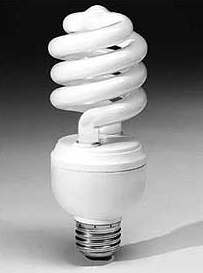 A coalition of industrialists, environmentalists and energy specialists is announcing next week a campaign to eliminate America’s use of incandescent light bulbs within 10 years. It will press for government-enforced efficiency standards to make the old-bulb technology obsolete. (After all, it dates back to the introduction of the telegraph and steam locomotive, which have long since been replaced by better technology.) –NY Times
A coalition of industrialists, environmentalists and energy specialists is announcing next week a campaign to eliminate America’s use of incandescent light bulbs within 10 years. It will press for government-enforced efficiency standards to make the old-bulb technology obsolete. (After all, it dates back to the introduction of the telegraph and steam locomotive, which have long since been replaced by better technology.) –NY Times
Energy-efficient lighting can produce a huge difference on your energy bill, and help cut global warming gases. Try this dimmable CF Warm Glow light bulb, from Gaiam.




















I wonder just how many industrialists, environmentalists and energy specialists it takes to change a light bulb?
Ha HAH!!!
🙂
As far as I know fluorescent lighting is not good for your eyes, something to do with their frequency, are these new bulbs any different? anyone knows about that?
These bulbs are not the long, flickering fluorescents that you might remember from schools and libraries. I have been using compact fluorescents for several years and have never had problems with my eyes (or anything else) – would never go back to incandescents.
I found this on wikipedia:
Flicker
Fluorescent lamps do not give out a steady light; instead, they flicker (fluctuate in intensity) at a rate that depends on the frequency of the driving voltage. While this is not easily discernible by the human eye, it can cause a strobe effect posing a safety hazard in a workshop for example, where something spinning at just the right speed may appear stationary if illuminated solely by a fluorescent lamp. It also causes problems for video recording as there can be a ‘beat effect’ between the periodic reading of a camera’s sensor and the fluctuations in intensity of the fluorescent lamp. The frequency is most noticeable on CRT computer monitors set with a refresh rate similar to the frequency of the bulbs, which will appear to flicker due to the beat effect. To resolve this flicker one may change their monitor’s refresh rate. Incandescent lamps, due to the thermal inertia of their element, fluctuate less in their intensity, although the effect is measurable with instruments. This is also less of a problem with compact fluorescents, since they multiply the line frequency to levels that are not visible. Installations can reduce the stroboscope effect by using lead-lag ballasts or by operating the lamps on different phases of a polyphase power supply.
(whatever that means!)
I’ve used the cfl and they have not bothered me like regular florescents in tubes, which I can’t stand for long periods…
hth
I was just informed by my natural eye practitioner that there is also full spectrum lighting for compact fluorescent. These offer the best for your eyes especially during reading/writing or close work times. I haven’t checked the prices yet, but the incandescents-full-spectrum are quite expensive (around $15 for 75 watts here in Canada)
Thanks for that clarification, Mone, I know it helped me.
Gaiam, a company that is advertised on GNN has a compact flourescent full spectrum they call SUNWAVE, in various brightnesses, for 25 bucks.
http://tinyurl.com/2shkyx
Natural sunlight color reduces eyestrain and increases visual acuity. Compact Sunwave Bulb design fits almost all household fixtures. This flicker-free bulb features an instant-starting electronic ballast and a 10,000-hour life. Fits any standard socket.
26W (120W equivalent).